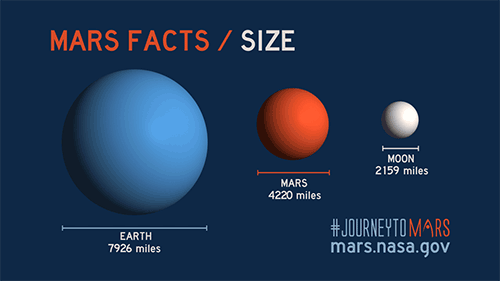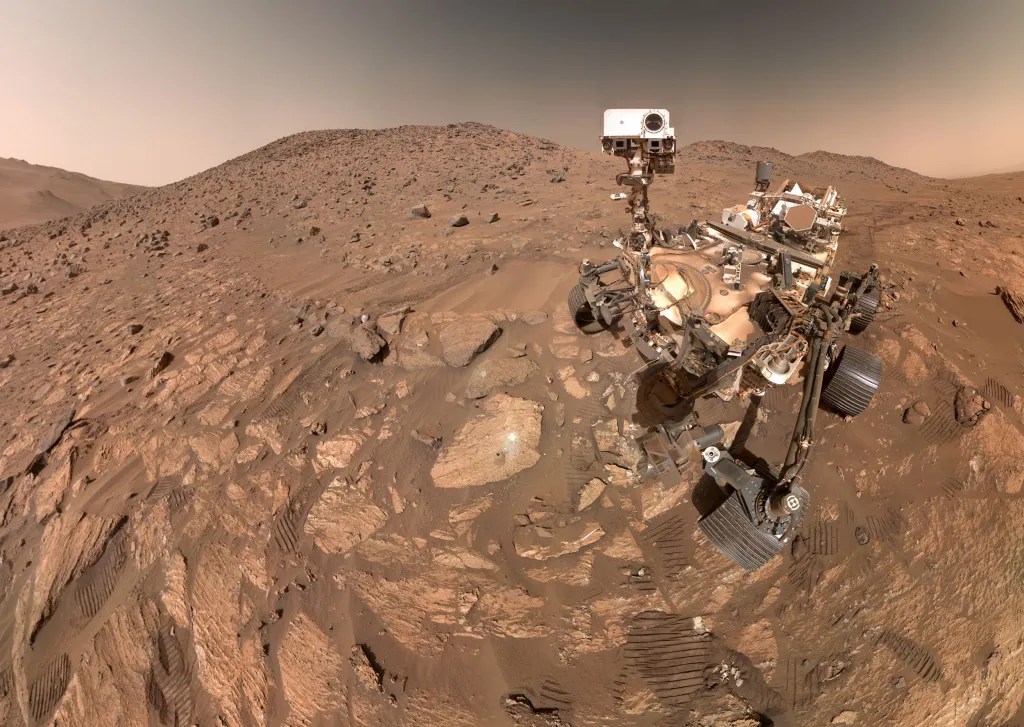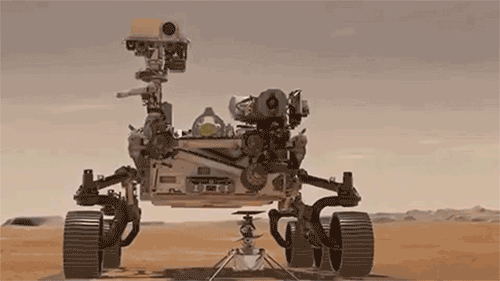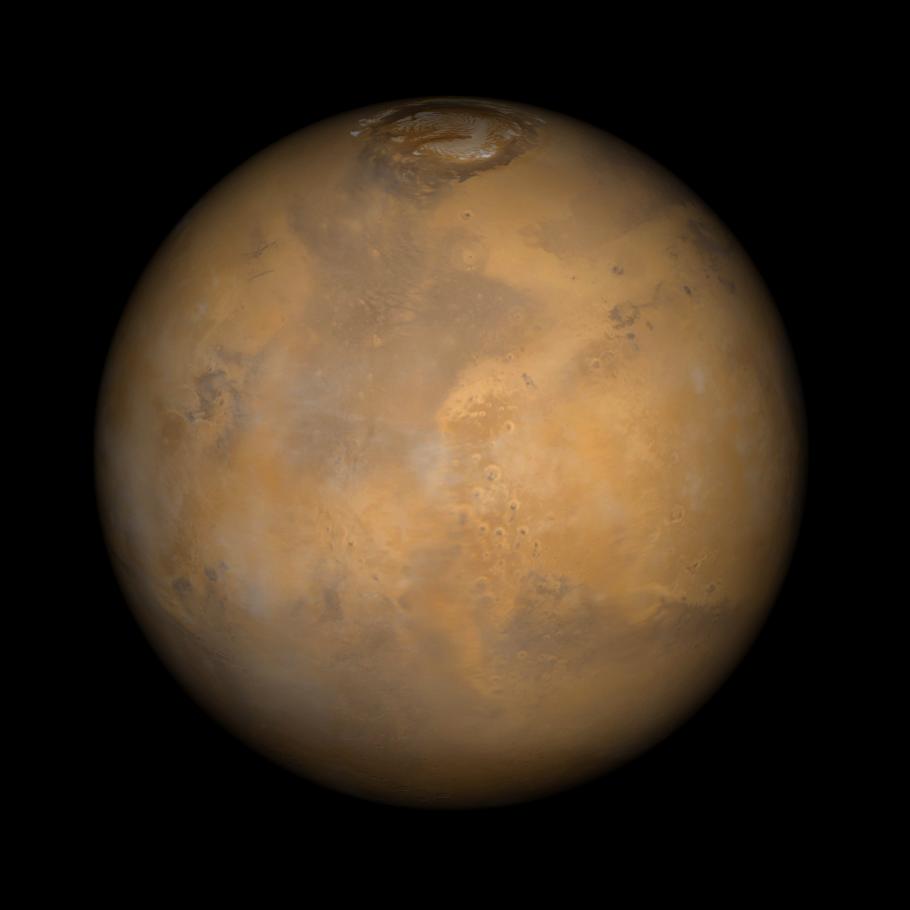This article is for students grades 5-8.
Mars is the fourth planet from the Sun and the next planet beyond Earth. It is, on average, more than 142 million miles from the Sun. Mars turns on its axis more slowly than Earth does. So, a day on Mars is 24.6 hours. Since this planet is farther from the Sun than Earth, one revolution of Mars around the Sun is a longer trip. So, a year on Mars is 687 Earth days. Mars is about half the size of Earth. Mars is known as the Red Planet because the iron oxide chemicals in its soil looks like rust.
Mars is named for the ancient Roman god of war. The Greeks called the planet Ares (pronounced Air-EEZ). The Romans and Greeks associated the planet with war because its color resembles the color of blood.
Mars has two small moons. Their names are Phobos (FOE-bohs) and Deimos (DEE-mohs). They are named for the sons of Ares, the Greek god of war. Phobos means “fear,” and Deimos means “panic.”
What Is Mars Like?
Mars is very cold. The average temperature on Mars is minus 80 degrees Fahrenheit — way below freezing!
Its surface is rocky, with canyons, volcanoes, dry lake beds and craters all over it. Red dust covers most of its surface. Mars has clouds and wind just like Earth. Sometimes the wind blows the red dust into a dust storm. Tiny dust storms can look like tornados, and large ones can be seen from Earth. Mars’ large storms sometimes cover the entire planet.
Mars has about one-third the gravity of Earth. A rock dropped on Mars would fall more slowly than a rock falls on Earth. A person who weighs 100 pounds on Earth would only weigh about 38 pounds on Mars because of the reduced gravity.
The atmosphere of Mars is much thinner than Earth’s. The Red Planet’s atmosphere contains more than 95% carbon dioxide and much less than 1% oxygen. People would not be able to breathe the air on Mars.
____________________________________________________________________________________
Words to Know
atmosphere: the layer of gases surrounding a planet
____________________________________________________________________________________
What Has NASA Learned About Mars?
NASA has used robotic spacecraft to learn more about Mars. In 1965, Mariner 4 flew past Mars and became the first NASA spacecraft to take close-up images of another planet. In 1976, Viking 1 and Viking 2 were the first NASA spacecraft to land on Mars. Both spacecraft took images and collected science data on the Martian surface.
Since then, several spacecraft have orbited, and some have landed on Mars. Scientists are particularly interested in searching for clues of water on Mars. Living things need water to survive. So, finding evidence that water exists or used to exist on Mars would mean that there could be, or could have been, life on the planet.
NASA’s Spirit and Opportunity rovers found evidence that water once flowed on Mars when they found minerals that only form in water. NASA’s Mars Global Surveyor studied the Red Planet for nine years. The orbiter found that Mars once had a magnetic field like Earth’s that shielded it from deadly cosmic rays.
____________________________________________________________________________________
Words to Know
orbit: to travel around something such as a planet or moon, in a curved path
orbiter: a spacecraft that travels around a planet or moon in space
____________________________________________________________________________________
How Is NASA Exploring Mars Today?
Today, three NASA spacecraft are orbiting Mars. The spacecraft are using scientific tools to collect information about things like climate, land features, the amount of radiation and the kinds of minerals on Mars. The Mars Odyssey holds the record for the spacecraft orbiting a planet for the longest time. It arrived in October 2001.
On the ground, the Curiosity rover and the InSight lander are studying the Martian surface. Curiosity has been studying the planet since 2012 and is the largest rover ever sent to another planet. The Insight lander arrived in November 2018. It studies the interior of the planet and measures marsquakes, which are like earthquakes on Mars. See which missions are exploring Mars now.
____________________________________________________________________________________
Words to Know
rover: a vehicle for exploring the surface of a planet or moon
lander: a type of spacecraft that touches down on a planet or moon; a lander does not move around
____________________________________________________________________________________
How Will NASA Explore Mars in the Future?
NASA’s ultimate goal is to send humans to explore the Red Planet. But first, the space agency plans to send more robots. The Perseverance rover carried a small helicopter and landed on Feb. 18, 2021. Perseverance has a tool that will try making oxygen like a tree does. It will inhale some of the large amounts carbon dioxide on Mars and exhale oxygen. This kind of tool could help to prepare for when humans first visit the planet. Astronauts will need oxygen for breathing and for fuel. A small helicopter named Ingenuity will disconnect from the rover and see if it can fly by itself on Mars. If it works, NASA could build other helicopters like it to help explore Mars or other planets.
Perseverance will also collect rocks and soil. The rover will store these until a future mission can go to Mars to bring the samples to Earth. This will be the first time that samples of another planet could be brought back to Earth for scientist to touch and study. After robots have explored the Red Planet and brought back soil samples, NASA wants to send astronauts there. To prepare to send humans to Mars, NASA is researching new kinds of homes where astronauts can live. Scientists are studying how people living in space can grow plants for food. To find out how living in space affects humans, NASA studies what happens to astronauts on the International Space Station. NASA will use this information to plan human trips to Mars!
More About Mars
Draw a Rover and Helicopter on Mars
NASA Space Place: All About Mars
NASA Space Place: The Mars Rovers
Mars Activities for Kids
Make a Paper Mars Helicopter
Explore Mars: A Mars Rover Game
Interactive 3D Rover Experience
Mars: The Red Planet































